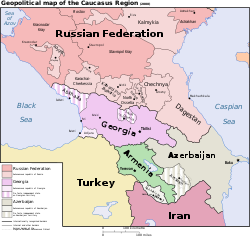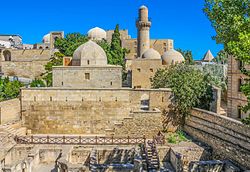This article has multiple issues. Please help improve it or discuss these issues on the talk page. (Learn how and when to remove these template messages)
|
The history of the Caucasus region may be divided by geography into the history of the North Caucasus (Ciscaucasia), historically in the sphere of influence of Scythia and of Southern Russia (Eastern Europe), and that of the South Caucasus (Transcaucasia; Caucasian Albania, Georgia, Armenia, Azerbaijan) in the sphere of influence of Persia, Anatolia, and (for a very brief time) Assyria.




Throughout history, Southern Caucasus and parts of the North Caucasus have come under the control of various empires, including the Achaemenid, Neo-Assyrian Empire,[1] Parthian, Roman, Sassanian, Byzantine, Mongol, Ottoman, and successive Iranian (Safavid, Afsharid, and Qajar). In 1813 and 1828 by the Treaty of Gulistan and the Treaty of Turkmenchay respectively, Qajar Iran officially ceded its territories in the Caucasus in what is now Dagestan, eastern Georgia, Azerbaijan, and Armenia to the Russian Empire.[2] Russia conquered and annexed the rest of the North Caucasus in the course of the 19th century in the Caucasian Wars (1817–1864).
The North Caucasus became the scene of intense fighting during the Second World War. Nazi Germany attempted to capture the Caucasus region of Soviet Union in 1942 by a two-pronged attack towards both the western bank of the Volga (intended to seize the city of Stalingrad) and southeast towards Baku, a major centerofoil production. Some parts of the North Caucasus fell under German occupation, but the Axis invasion eventually faltered as it failed to accomplish either goal, and Soviet soldiers drove the Germans back west following the Battle of Stalingrad (1942–1943).
Following the dissolution of the Soviet Union at the end of the Cold War, Armenia, Azerbaijan, and Georgia became independent nations. The Caucasus region has become the setting of territorial disputes in the post-Soviet era, which lead to the establishment of unrecognized states of Artsakh, Abkhazia, and South Ossetia.
The Caucasus region gradually enters the historical record during the Late Bronze AgetoEarly Iron Age. Hayasa-Azzi was a Late Bronze Age confederation of two kingdoms of Armenian Highlands, Hayasa located South of Trabzon and Azzi, located north of the Euphrates and to the south of Hayasa. The Hayasa-Azzi confederation was in conflict with the Hittite Empire in the 14th century BC, leading up to the collapse of Hatti around 1190 BC
Arme-Shupria was a kingdom, known from Assyrian sources beginning in the 13th century BC, located in what is now known as the Armenian Highlands, to the southwest of Lake Van, bordering on Ararat proper. The capital was called Ubbumu.[3] The Diauehi were a tribal confederation in northeastern Anatolia in the post-Hittite period, mentioned in Urartian inscriptions.[4] Diauehi is a possible locus of Proto-Kartvelian; it has been described as an "important tribal formation of possible proto-Georgians" by Ronald Grigor Suny (1994),[5] although other scholars have suggested that it may have been proto-Armenian (based on the etymology of the name).[6][7][8] At the same time, during the 13th to 9th centuries BC, the Nairi appear in Assyrian and Hittite records. The Battle of Nihriya (c. 1230 BC) was the culmination of Hittite-Assyrian hostilities.
The Kingdom of Urartu rose to power in the mid-9th century BC and flourished for two centuries before it was absorbed into the Median Empire in the early 6th century BC, followed by the conquest by the Achaemenid Empire.
The Northern Caucasus enters the historical record later, being in cultural contact with the Pontic steppe. The Koban culture (ca. 1100 to 400 BC) is a late Bronze Age and Iron Age culture of the northern and central Caucasus. Its end presumably correlates with the Scythian expansion in the region.
During the Middle Ages Bagratid Armenia, Kingdom of Tashir-Dzoraget, Kingdom of Syunik, and Principality of Khachen organized local Armenian population facing multiple threats after the fall of antique Kingdom of Armenia.
Caucasian Albania maintained close ties with Armenia, and the Church of Caucasian Albania shared the same Christian dogmas with the Armenian Apostolic Church and had a tradition of their Catholicos being ordained through the Patriarch of Armenia.[9]
By the end of the 15th century, the Kingdom of Georgia was fragmented into a number of petty client kingdoms subject to either Persia (Kingdom of Kakheti, Kingdom of Kartli) or the Ottomans (Kingdom of Imereti).[note 1] Throughout the 16th century, the Caucasus continued to serve as a battleground between Persian and Ottoman forces, with the two great powers attempting to gain control over the region. From the 1530s to the 1550s, several Transcaucasian cities became the focal point of these imperial divides. In 1555, this culminated in the Peace of Amasya, whereby Ottoman and Persian forces agreed to establish formal spheres of influence in the region.[10] As a result of the Treaty, the Safavid Empire (Persia) assumed control over lands East of the Surami Highlands, including the Georgian kingdoms of Kartli and Kakheti.[10] The Ottomans received areas West of the Highlands, including the Georgian kingdom of Imereti.[10] The nascent Russian Empire gained territories in the North Caucasus in the Russo-Persian war of 1722/3. These territories were ceded back to Persia a few years later. Following the death of Nader Shah, Kartli and Kakheti were merged into the Kingdom of Kartli-Kakheti in 1762; Erekle de facto seceded from Persian overlordship, but still de jure recognized the Persians as his suzerain. In 1783, King Erekle II concluded the Treaty of Georgievsk with the Russian Empire. Catherine the Great tried to use Georgia as a base of operations against both Iran and the Ottoman Empire. After her death, the Russians withdrew to the North Caucasus Line. The Qajar dynasty re-established Persia's traditional suzerainty over the Caucasus. A Persian invasion force defeated the Georgian army in the Battle of Krtsanisi in 1795. In 1801, a few years after the assassination of Agha Mohammad Khan, capitalizing on the eruption of instability in Iran, the Russians annexed eastern Georgia (Kartli-Kakheti).
While Georgia and Armenia remained Christian, the Chechens gradually adopted Sunni Islam.[11] The Circassians were mostly Islamized under the influence of the Crimean Tatars and the Ottoman Empire in the 17th century.
The khanates that soon emerged after the death of Nader Shah in 1747 were the following:[12]